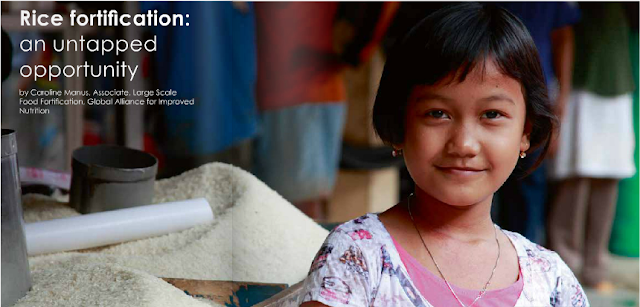by Caroline Manus, Associate, Large Scale Food Fortification, Global Alliance for Improved Nutrition
First published in Milling and Grain, July 2015
Of the 222 million metric tons of rice that is industrially milled each year, less than one percent is fortified with essential vitamins and minerals. Globally, 82 countries have mandatory legislation to fortify wheat and maize flour, but the opportunity to leverage rice to improve public health has yet to be tapped on a large scale.
Only six countries currently have mandatory rice fortification legislation, although voluntary fortified rice is available in Brazil, Columbia and the Dominican Republic. However, the accessibility of fortified rice ranges across the countries.
In advance of the world’s first-ever global summit on Food Fortification (#FutureFortified), co-hosted by the Global Alliance for Improved Nutrition (GAIN) and the Government of Tanzania, we examine food fortification developments taking place around the globe.
Rice fortification’s role in ending ‘hidden hunger’
Globally, an estimated two billion people are affected by micronutrient malnutrition or ‘hidden hunger’. Its negative and often lifelong consequences for health, growth, immune and reproductive functions, productivity and mental development are devastating.
Micronutrient deficiencies affect all age groups, but young children and women of reproductive age are particularly vulnerable. Worldwide, the most prevalent micronutrient deficiencies are iron, zinc, vitamin A, iodine and folate.
In some developing countries, several different micronutrient deficiencies can occur simultaneously. Micronutrient deficiencies are accountable for approximately seven percent of the global burden of disease.
In this article, GAIN’s Caroline Manus outlines how fortification of one of the world’s most widely consumed commodities, rice, should become a higher international development priority.
Only six countries currently have mandatory rice fortification legislation, although voluntary fortified rice is available in Brazil, Columbia and the Dominican Republic. However, the accessibility of fortified rice ranges across the countries.
In advance of the world’s first-ever global summit on Food Fortification (#FutureFortified), co-hosted by the Global Alliance for Improved Nutrition (GAIN) and the Government of Tanzania, we examine food fortification developments taking place around the globe.
Rice fortification’s role in ending ‘hidden hunger’
Globally, an estimated two billion people are affected by micronutrient malnutrition or ‘hidden hunger’. Its negative and often lifelong consequences for health, growth, immune and reproductive functions, productivity and mental development are devastating.
Micronutrient deficiencies affect all age groups, but young children and women of reproductive age are particularly vulnerable. Worldwide, the most prevalent micronutrient deficiencies are iron, zinc, vitamin A, iodine and folate.
In some developing countries, several different micronutrient deficiencies can occur simultaneously. Micronutrient deficiencies are accountable for approximately seven percent of the global burden of disease.
In this article, GAIN’s Caroline Manus outlines how fortification of one of the world’s most widely consumed commodities, rice, should become a higher international development priority.
Read the full article in Milling and Grain HERE.
This blog is maintained by The Global Miller staff and is supported by the magazine GFMT
which is published by Perendale Publishers Limited.
For additional daily news from milling around the world: global-milling.com



No comments:
Post a Comment